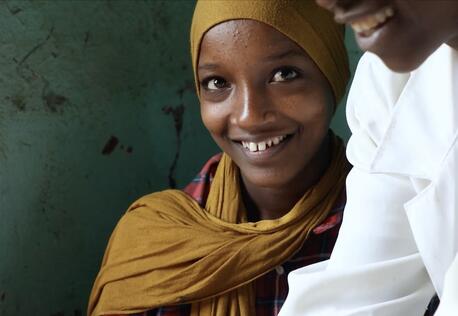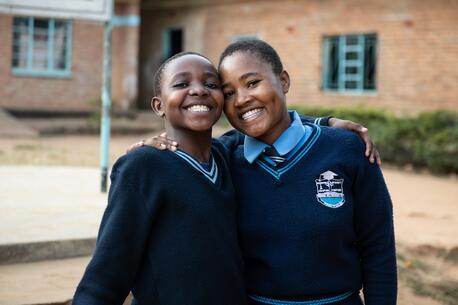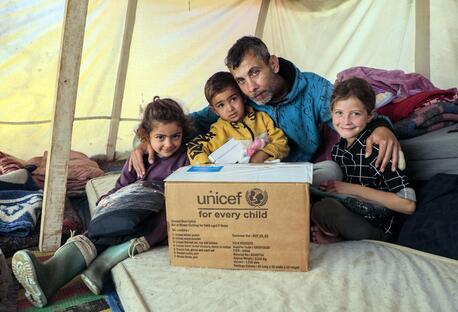
How UNICEF Innovates for Children
New technologies are making the difference in fending off disease, malnutrition and sexual attacks — and they're giving kids a voice in improving their own lives.
Sometimes something as simple as a biscuit will open the door to a lifesaving breakthrough.
UNICEF used to offer biscuits to severely malnourished children, but they were hard to chew and swallow. So UNICEF partnered with the private sector and others to come up with an alternative. The result was peanut paste, an innovative blend of protein and nutrients we call Ready-to-Use Therapeutic Food, or RUTF, to bring starving children back to life.
That was 12 years ago, and it's just one example of how UNICEF is constantly innovating to find new and improved ways to save and protect children in need.
We get a lot of help. At UNICEF Innovation, we are constantly reaching out to the private sector — teaming up with companies like S’well or Johnson & Johnson — to find out what they are developing or producing that we might be able to bend toward fulfilling children's needs in places like Madagascar and Sri Lanka.
When we approach these potential partners, or when a potential partner comes to us, we sit down and talk through some of the challenges we’re trying to solve. We find out what kinds of skills they can bring to the table, and what we can learn from them that will help us do what we do better and faster.

Nutrient-rich peanut paste, known as Ready-to-Use Therapeutic Food, or RUTF, was an early innovation driven by UNICEF and partners to more effectively treat children suffering from severe acute malnutrition. © UNICEF/UN025832/Malik
I'll give you an example of how this can work out brilliantly. We were in West Africa during the Ebola outbreak. It was terrifying. Here was a disease that was moving so quickly that we couldn’t get ahead of it. We needed more than just money to support our response; we required information technology and tools. So we teamed up with engineers from Google — mobile network operators — to help us figure out what data we needed, how to get it, how to process it and apply it efficiently and effectively.
A fantastic thing happened. We looked at ferry routes, at how people were traveling to and from their communities, and between villages and markets. Based on that data collection and analysis, we were able to track where Ebola would turn up next. And then we took those lessons to Brazil, to fight the Zika virus.
Working with governments helps ensure that our interventions have a lasting impact.
Public sector partnerships are critical, too. Working with governments helps ensure that our interventions have a lasting impact, and not just for Innovation projects but for all UNICEF programs and initiatives.
Here's another example: In Uganda, we discovered that most rural areas faced chronic shortages of drugs needed to prevent and treat malaria — a leading killer of children in Africa. To address this problem, we connected the health facilities to our RapidPro mobile communications platform, so that health workers could text their resupply requests to their districts rather than wait for a response from the central hub, which took a lot longer. To allow them to do this, we had to work with the Ugandan government to change the policy around how essential medicines were distributed in the country. All these efforts paid off: Stock-out rates dropped from 72% to 14% in just 15 months.
A 2-year-old plays outside a health facility in Kwagala, in the Iganga district, Uganda, while anti-malarial bednets air out in the trees. A messaging service built on top of one of UNICEF's most successful innovations — the RapidPro mobile communications platform — helps small clinics across the country maintain adequate supplies of anti-malarial drugs and other essential medicines. © UNICEF/UN070981/Bongyereirw
We’re also using our RapidPro platform to empower youth through a two-way messaging service called U-Report. Through basic SMS, Facebook Messenger and other popular texting apps, it allows users to share information, flag issues that are important to them and voice their concerns in a very immediate, actionable way.
We have 4.7 million "U-Reporters" now in Malawi, Mozambique, Nigeria, Pakistan and three dozen other countries. And they are engaging on a range of topics, from menstrual hygiene to preventing the spread of disease to where to find shelter in an emergency. U-Report provided alifeline for those trapped by Hurricane Irma in September 2017. It kept young people in Sierra Leone stay connected and informed in the wake of devastating landslides. It did the same in Côte d’Ivoire, during the floods in Abidjan.
We have 4.7 million 'U-Reporters' now in Malawi, Mozambique, Nigeria, Pakistan and three dozen other countries.
U-Report has also been an effective tool for young advocates to help drive change. During the Ebola crisis, we used it as a communications tool to disseminate potentially lifesaving information and to assist the emergency response. But we also used it to poll young people, asking general questions, such as, ‘What are you worried about?’ and ‘What’s going on in your life?’ to get a better read on their needs. (James Powell, our U-Report Global Lead, explains what makes the difference between a strong youth engagement platform and a rubbish one.)
When we did the poll in Liberia, thousands of kids responded, and shared something unexpected, and horrifying: They told us that they were being sexually abused by their teachers at school. We received many messages from girls saying that they felt pressure to acquiesce in order to get good grades.
We took the information to the government and pressed for action, and it responded, passing stricter laws and changing enforcement policies and practices. I don’t think we would have known the extent of the problem if we hadn’t provided these kids with a direct — and anonymous — way to report it. It is critical that we keep using these tools we have developed, and keep asking kids what is going on in their communities.
It is critical that we keep using these tools we have developed, and keep asking kids what is going on in their communities.
While we continue to build on our existing innovations, we keep looking for new ones. Through our Innovation Fund, we’re supporting the development of a broad range of frontier technologies, from drones to 3D printing to artificial intelligence, to name just a few. Through our Ventures team, we're exploring how blockchain can support our fieldwork. These are exciting times for UNICEF Innovation, and we’re growing like gangbusters.
To quote our Executive Director Henrietta H. Fore: Innovation has always been an important part of UNICEF's story. And we will not reach many of the Sustainable Development Goals without a significant step change in our work. Innovation provides an opportunity to make this leap, and do what generations of UNICEF staff members have always done: apply new thinking to old problems.
The operative word there is "part." A recent evaluation of the use of RapidPro to increase the use of maternal and child health services in Rwanda found that use of the mobile tool alone was not enough to drive results; that combining the new messaging capabilities with additional support, in the form of staff and facility trainings, upskilling and capacity building, was the key to the success of that effort.
To date, UNICEF has helped 85 countries identify, adopt and adapt innovative solutions that are used by 18 million young people, women and frontline workers.
For an in-depth look at our achievements in innovation over the past year — and the challenges still ahead — see the latest report from UNICEF's Global Innovation Center. To date, we've helped 85 countries identify, adopt and adapt innovative solutions that are used by 18 million young people, women and frontline workers, and that indirectly benefit another 97 million children and their communities.
I'm excited about the future and what it holds for our many Innovation projects and investments. Learn more about what we're doing by visiting the Innovation website, and let us know what you think.
Cynthia McCaffrey is the Director of the UNICEF Office of Innovation. She joined UNICEF in 2001.
Top photo: U-Reporters in Cote d'Ivoire are using the platform to participate in public debate, sharing their concerns and helping to influence solutions to community problems. When Abidjan was hit with massive flooding in June 2017, the system helped get information out about local conditions and keep families safe. © UNICEF/UN061350/Delongh
HOW TO HELP
There are many ways to make a difference
War, famine, poverty, natural disasters — threats to the world's children keep coming. But UNICEF won't stop working to keep children healthy and safe.
UNICEF works in over 190 countries and territories — more places than any other children's organization. UNICEF has the world's largest humanitarian warehouse and, when disaster strikes, can get supplies almost anywhere within 72 hours. Constantly innovating, always advocating for a better world for children, UNICEF works to ensure that every child can grow up healthy, educated, protected and respected.
Would you like to help give all children the opportunity to reach their full potential? There are many ways to get involved.





